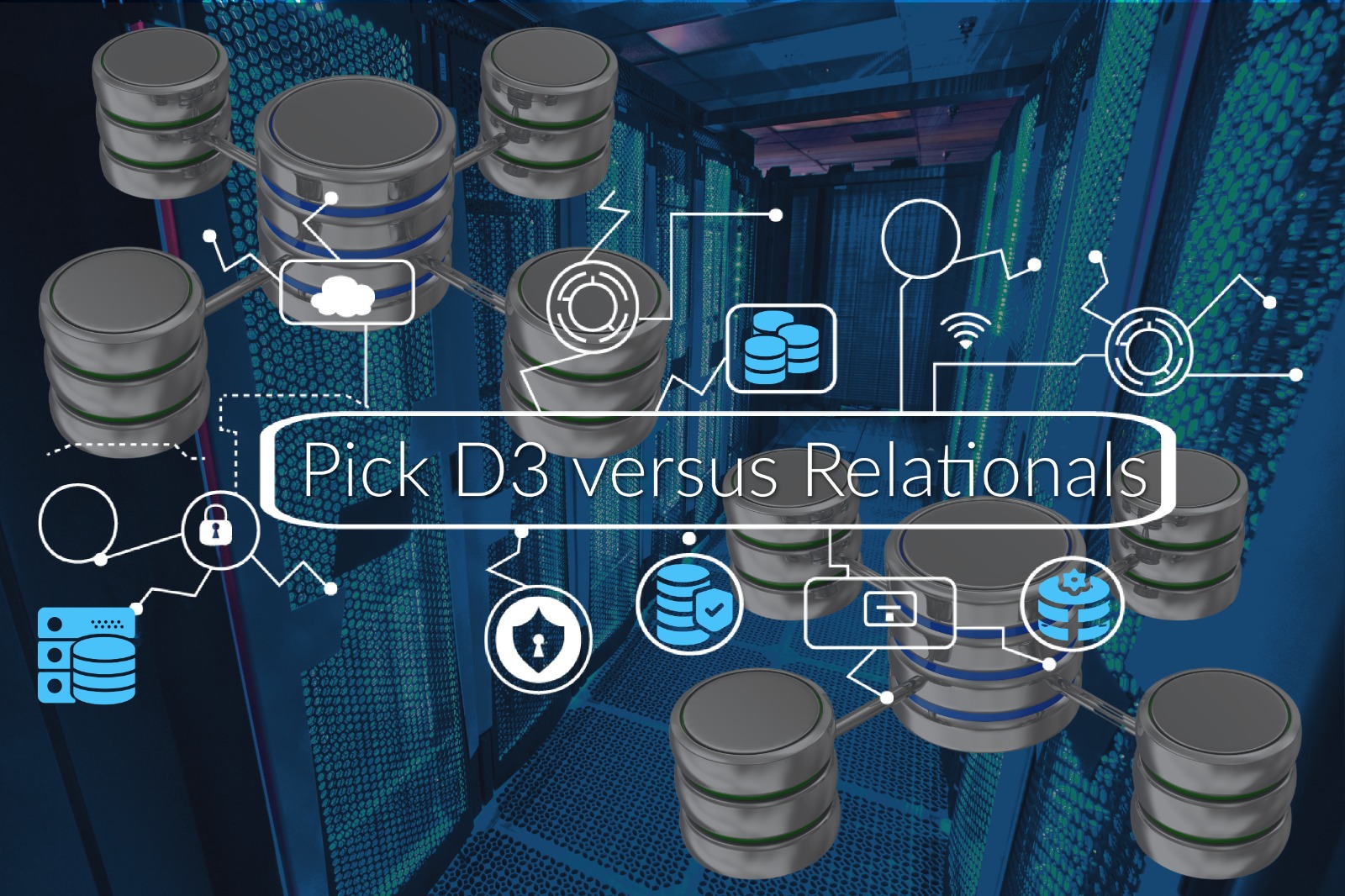Discover how the flexibility and scalability of Pick D3 can take your IoT and AI projects to the next level.
Something about History:
The Pick D3 database, also known as D3, originated in the 1960s by the Pick Systems company. At that time, database systems were very rudimentary and based on storing information in plain text files. Pick Systems changed this by creating a hierarchical database that allowed users to store and retrieve information more efficiently.
The Pick D3 database was launched in 1984 and quickly became a popular tool for companies in need of a reliable and scalable data storage solution. Its hierarchical structure allowed users to organize information in layers, making data management and access easier.
During the 1990s and early 2000s, the popularity of Pick D3 declined due to the emergence of more powerful relational databases such as Oracle and SQL Server. However, Pick D3 still had a loyal user base who appreciated its ease of use and efficiency in data management.
Rocket Software acquired IBM’s U2 product family in 2010 and TigerLogic’s D3 and mvBase product family in 2014 (Source: Wikipedia), taking responsibility for developing and maintaining the Pick D3 database. Rocket Software has continued to innovate with the database and improved its performance and scalability to meet the needs of current users.
Today, Pick D3 remains a popular solution for companies in need of a reliable and scalable database. Although it is no longer the most popular database, it remains an important tool for companies in need of a data storage solution that is easy to use and manage
Pick D3, IOT and IA

The Internet of Things (IoT) and Artificial Intelligence (AI) are two technologies that are rapidly transforming the way we interact with the digital and physical world around us. With the increasing number of connected devices, the need for an efficient and scalable database platform has become increasingly important.
In this context, Pick D3, a MultiValue database, can be a very useful tool for IoT and AI projects. The flexibility and scalability of Pick D3 make it ideal for handling large amounts of data generated in IoT projects, and its ability to integrate with multiple devices is crucial in creating a universal network of connected objects.
Furthermore, Pick D3’s ability to handle multiple values in a single field can be very useful in AI projects, where managing and analyzing large amounts of data is crucial to success. There is also an effort in the tech community to find a universal language for connected objects, and Pick D3 can be an efficient solution to help build this platform.
In this context, exploring how Pick D3 can be used in IoT and AI projects can help developers build more efficient and scalable systems and advance the search for a universal language for connected objects. In this introduction, we will explore how Pick D3 can be used in IoT and AI projects and how it can help developers tackle the challenges of managing and analyzing data in an increasingly connected world.
Pick D3 versus Relationals

Pick D3 is a MultiValue database, which means that it uses a unique data storage technology that is different from traditional relational databases. Unlike relational databases, which use tables to store data, MultiValue databases like Pick D3 use a hierarchical structure that allows users to store information in layers. This means that data can be organized into multiple levels of depth, making data management and access easier.
Another important difference between MultiValue databases and relational databases is that the former do not require a predefined schema. In relational databases, a schema must be defined for each table before data can be added to it. In contrast, in a MultiValue database like Pick D3, data can be added without the need for a predefined schema, making it more flexible.
Additionally, the technology used by Pick D3 allows users to store multiple values in a single field, which means that data can be more complete and specific. This is achieved through the use of value and subvalue lists, which means that data can be more easily organized and queried.
In summary, the technology used by Pick D3 is unique and offers a flexible and efficient alternative to traditional relational databases. The hierarchical structure, ability to store multiple values in a single field, and lack of a predefined schema are some of the most important differences between MultiValue databases and relational databases.
Why Pick D3
Pick D3 is a MultiValue database that has several powerful features that distinguish it as one of the best MultiValue databases. Some of these features include:
Integrated file systems: Pick D3 has integrated file systems that allow users to store data in a structured format. This means that data can be stored more efficiently and organized, which makes data management and access easier.
Client-server architecture: Pick D3 offers a client-server architecture that allows users to access the database remotely. This means that users can access the database from anywhere and at any time, improving flexibility and accessibility.
Integration with programming languages: Pick D3 integrates with several programming languages, including BASIC (native language of Pick D3), Java, C#, C++, and Python, making it easier to create customized applications.
Scalability: Pick D3 is highly scalable and can handle large amounts of data and users simultaneously (there are installations of Pick D3 that work with more than 1000 users approximately simultaneously). This makes it ideal for companies that need a reliable and scalable database solution.
Pick D3 has several unique features that make it stand out from other MultiValue databases. Its integrated file systems, client-server architecture, integration with programming languages, and scalability are some of the most outstanding features that make Pick D3 an attractive solution for companies that need a reliable and scalable database solution.
The Magic of the Pick D3 Framework

The Pick D3 framework is an additional layer that runs on top of the database, providing a complete and versatile solution that goes beyond a simple MultiValue (MV) database. In addition to offering a powerful MV database, Pick D3 also includes a wide range of native tools in its framework, which is a great advantage for its users. By acquiring a Pick D3 license, you not only get access to a high-quality MV database, but also to a wealth of integrated tools that allow you to efficiently manage, analyze, and visualize your data.
Among the tools included in the Pick D3 framework are the mvBASIC programming language, which allows the development of custom applications for data management, the mvENTERPRISE compiler, which allows the creation of high-speed programs, and the mvQUERY reporting system, which allows for the generation of custom reports and real-time data visualizations. In addition, Pick D3 also includes tools for security management, integration with other systems, remote access, and performance management.
This variety of integrated tools makes the Pick D3 framework an all-in-one solution, which is very cost-effective for companies as it avoids the need to acquire additional licenses for third-party tools and eliminates the need to install and configure separate tools. In short, Pick D3 offers a complete, powerful, and efficient solution for data and application management, making it an excellent option for companies looking for a comprehensive and cost-effective solution for their data management needs.
Advantages of Pick D3 in IoT and AI
There are several advantages that Pick D3 can offer in Internet of Things (IoT) and Artificial Intelligence (AI) projects:
Flexibility in data management: Pick D3 is a highly flexible and scalable database that allows users to store and manage large amounts of data efficiently. In an IoT and AI project, where large amounts of data are managed, this is a key advantage that can help improve data management efficiency.
Integration with multiple devices: Pick D3 can integrate with a variety of devices and systems, making it ideal for IoT projects. The ability to integrate data from multiple sources into a single database is crucial for the success of an IoT project, and Pick D3 can help achieve this efficiently.
Remote access: Pick D3 offers a client-server architecture that allows users to access the database from anywhere at any time. In an IoT and AI project, where users are likely to be working from remote locations, this can be an important advantage.
Data analysis tools: Pick D3 offers a variety of data analysis tools that can be useful in AI projects. These tools allow users to analyze large amounts of data quickly and efficiently, which can help identify important patterns and trends.
Pick D3 offers several key advantages in IoT and AI projects, including flexibility in data management, integration with multiple devices, remote access, and data analysis tools. These advantages can help improve the efficiency and effectiveness of IoT and AI projects.
At creamostuapp.com we have a professional team led by Victor Machado, a technician and expert with over 40 years of experience in Pick D3 projects.
Discover the power of Pick D3 and improve data management in your company. Contact us today to start your journey towards more efficient and effective data management. And if your company already uses this system and requires technical support, do not hesitate to contact us. We are your best option.
Credits: Text in collaboration with Victor Machado.
















